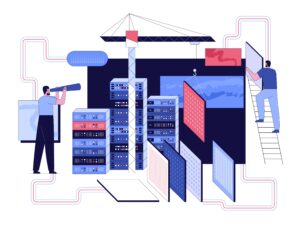In today’s data-driven world, efficiently and accurately capturing data has become crucial for businesses. Data capture is pivotal in harnessing valuable insights from customer information to market trends. Follow along to clarify the concept of data capture, its purpose, methods, tools, challenges, and significance across various industries.
What is Data Capture?
Data capture is a process that involves extracting information from diverse sources, such as structured or unstructured documents, whether in paper or electronic form, and converting it into a machine-readable digital format.
It enables organizations to collect valuable information from physical documents, digital files, or real-time interactions, making it accessible for analysis, decision-making, and deriving insights.
What Is The Purpose Of Data Capture?
Data capturing primarily aims to acquire accurate and reliable information that can be leveraged for decision-making, analysis, and gaining a competitive edge. It enables businesses to transform raw data into actionable insights, enhance customer experiences, and drive innovation.
Here are some key purposes of data capture:
1. Decision-Making
Data capture enables organizations to gather relevant data that can be analyzed to make informed decisions. By capturing data from multiple sources, organizations can get valuable insights into customer behavior, allowing them to make data-driven decisions that align with their strategic goals.
2. Analysis and Reporting
Data collection provides the raw material for analysis and reporting. By capturing data in a structured format, organizations can easily analyze and interpret the information, identify patterns, trends, and correlations, and generate meaningful reports and visualizations. These insights facilitate monitoring, evaluation, and performance measurement, helping organizations to optimize their operations and identify growth opportunities.
3. Process Optimization
Capturing data plays a crucial role in optimizing business processes. By capturing data at various touchpoints, organizations can identify bottlenecks, inefficiencies, and areas for improvement. This enables them to streamline operations, eliminate redundant tasks, and automate manual processes.
4. Business Intelligence
Data capture forms the basis for business intelligence initiatives. Organizations can build comprehensive data repositories or warehouses by capturing and integrating data from multiple sources. These repositories are a foundation for advanced analytics, data mining, and machine learning, enabling organizations to gain deeper insights, predict trends, and drive strategic decision-making.
Difference Between Data Capture and Data Collection
While data capture and data collection are related concepts in data management, they have distinct differences in scope and methodology.
Data capturing is about extracting and recording data from existing resources and converting it into a digital format that can be easily used and analyzed. It involves using tools or technologies to capture specific data elements, like a scanner, to extract information from a paper document.
Data collection, on the other hand, has a broader focus. It is about actively gathering new data from primary sources. It’s often done at the beginning of a research or information-gathering process to address specific questions or objectives.
Example of Data Capturing
Consider the scenario where a retail business has accumulated many paper receipts from its day-to-day transactions. The data is already gathered, but the business can leverage data capture tools to organize and utilize it effectively. The retail business can extract relevant information from the paper receipts and convert it into a structured digital format using data capturing tools. These tools can automatically capture key details such as transaction dates, item descriptions, prices, and payment methods.
What Type of Data Can Be Captured?
Various data types can be captured, from structured to unstructured, depending on the source and purpose. Here are some common types of data that can be extracted:
-
- Text Data: Textual data is one of the most common types of capturing. It includes written or typed information, such as customer names, addresses, product descriptions, email correspondence, social media posts, or survey responses.
- Numeric Data: Numeric data refers to quantitative information that can be captured and processed for analysis. It includes sales figures, inventory quantities, sensor readings, invoice data, payment details, pricing, discounts, and financial statements.
- Image Data: Image data can be captured through various means, including photographs, scanned documents, or screenshots. This data type allows for extracting visual information, such as barcodes, QR codes, product images, or handwritten notes.
- Audio Data: Audio data can be captured through voice recordings, phone calls, or audio files. Audio capturing is often used for voice recognition, transcription, or sentiment analysis.
Methods of Data Capture
Data capturing can be accomplished through different methods, depending on the nature of the data, the source from which it is being captured, and the available resources.
Here are some common methods of data capture:
- Manual Data Capturing
Manual data capture involves a human intervention to enter data into a system or a digital format. This method often requires individuals to manually input data from various sources, such as paper documents, forms, or surveys, into a computer, database, or spreadsheet. Manual capturing can be time-consuming and prone to human errors. Still, it suits situations where automation could be more feasible and cost-effective.
- Automated Data Capturing
Automated data capturing relies on technology and tools to extract data from its source without manual intervention. It involves using software applications, algorithms, or specialized tools to automatically collect, process, and store data. Automation can include techniques such as optical character recognition (OCR), barcode or QR code scanning, sensor data collection, or web scraping.
What Are Data Capture Tools?
Data capture tools are software applications or technologies that come in various forms and serve specific purposes. They are helpful business assistants designed to simplify collecting, extracting, and managing data from different sources.
Let’s explore some commonly used data capture tools:
Optical Character Recognition (OCR)
Optical Character Recognition is a technology that converts printed or handwritten text into machine-readable characters. OCR software analyzes scanned documents, images, or files and identifies the characters present in them. It can accurately extract text from various sources such as invoices, receipts, forms, or books. OCR enables the automated capture of textual data, eliminating the need for manual transcription and significantly speeding up the process of digitizing documents.
Barcode or QR Code Scanning
Barcodes and QR codes are machine-readable codes that contain encoded information. Code scanning technology is used to extract data from these codes quickly. Scanning devices like barcodes or smartphone cameras can read the codes and retrieve the embedded information. This technology is commonly used in retail, logistics, and inventory management systems to capture product details, track shipments, or manage stock levels efficiently.
Web Scraping
Web scraping automatically extracts data from websites. It involves using software tools or scripts to navigate web pages, locate specific data elements, and pull the desired information. Web scraping enables the automated capture of data from online sources, such as product details, customer reviews, pricing information, or market trends. This technology is widely utilized in market research, competitive analysis, and data aggregation for various industries.
Importance Of Data Capturing For Enterprises
Data capturing is paramount for enterprises as it enables them to make informed decisions, understand their customers, and enhance operational efficiency. By capturing and analyzing relevant data, enterprises attain valuable insights for improvement. This information empowers enterprises to make strategic choices that drive growth and maintain a competitive edge. Effective data capturing streamlines processes reduces errors, and optimizes resource allocation, improving operational efficiency and cost savings. Moreover, data capturing helps enterprises mitigate risks, ensure compliance with regulations, and foster a culture of innovation by adapting to changing market dynamics and identifying emerging opportunities.
The Power Of Automated Data Capturing For Enterprises
Automated data capture provides numerous advantages for enterprises, revolutionizing their data management processes.
Here are the key benefits of implementing automated data capturing in an enterprise setting:
1. Streamlined Operations
Automated information capture streamlines data entry and processing, resulting in smoother operations. By eliminating manual data entry tasks, employees can focus on more critical business activities, enhancing productivity and reducing the risk of errors. This streamlined workflow leads to improved efficiency and optimized resource allocation within the enterprise.
2. Enhanced Data Accuracy
Information extraction technologies, such as OCR and barcode scanning, offer high accuracy levels, minimizing errors commonly associated with manual data entry. This improved accuracy ensures reliable and consistent data for informed decision-making, precise analytics, and regulatory compliance. High-quality data enhance enterprise performance and mitigates risks associated with data inconsistencies.
3. Cost and Time Savings
By automating data extraction, enterprises can reduce costs associated with manual labor, including hiring and employee management. The time saved through automation leads to faster data processing and shorter turnaround times, enabling timely decision-making. Moreover, automated data capture reduces error correction, rework, and manual verification costs, resulting in significant cost savings in the long run.
4. Scalability and Flexibility
Automated information capture systems are highly scalable, allowing enterprises to handle large volumes of data without sacrificing performance or accuracy. As business requirements evolve, these systems can be easily scaled up to accommodate increased data capture needs. Furthermore, automated solutions offer flexibility in capturing data from various sources, including paper documents, electronic files, and web-based applications.
5. Improved Data Governance and Compliance
Automation enables enterprises to enforce data governance policies and adhere to regulatory compliance requirements. By capturing and managing data in a structured manner, enterprises can establish data quality standards, implement data validation rules, and maintain an audit trail of data capture activities. This ensures data integrity, privacy, and compliance with data protection regulations.
6. Real-time Analytics and Insights
Automated captured data allows enterprises access to real-time or near real-time data, allowing for prompt analysis and decision-making. Enterprises can leverage captured data to generate actionable insights, monitor key performance indicators (KPIs), and identify trends and patterns. Real-time analytics enables agile decision-making, providing a competitive edge in dynamic business environments.
7. Integration with Existing Systems
Automated data-capturing technologies can seamlessly integrate with enterprise applications and systems, such as customer relationship management (CRM), enterprise resource planning (ERP), or business intelligence (BI) tools. This integration facilitates the seamless flow of captured data across different systems, ensuring data consistency and enhancing cross-functional collaboration.
8. Competitive Advantage
By implementing automation in data extracting, enterprises gain a competitive advantage regarding operational efficiency, data-driven decision-making, and customer service. Streamlined operations, accurate data, real-time insights, and improved customer experiences contribute to overall business performance and differentiation in the marketplace.
Challenges Of Data Capture For Businesses
Data capturing poses specific challenges for businesses, particularly retailers, due to the diverse nature of their operations. Here are some challenges of data capturing in the context of businesses and retailers:
Multiple Data Sources
Retailers gather data from various sources, such as point-of-sale (POS) systems, customer loyalty programs, online transactions, and inventory management systems. Integrating and capturing data from these disparate sources can be challenging, as each system may have different data formats and structures.
Data Volume and Velocity
Retailers deal with massive data generated daily, including sales transactions, customer interactions, and inventory updates. Capturing and processing this high volume of data in real-time or near real-time can strain data-capturing systems, requiring robust infrastructure and optimized processes.
Data Privacy and Security
Retailers handle sensitive customer data, including personal and financial information. Protecting this data from security breaches, ensuring compliance with data protection regulations, and maintaining customer trust are the main challenges in data capture.
Legacy Systems and Integration
Retailers may have legacy systems incompatible with modern data capture technologies. Integrating these systems with newer data capture tools requires careful planning, data migration, and ensuring seamless data flow between systems.
Training and Skill Development
Effective utilization of data capture tools and technologies requires training employees to understand and operate these tools efficiently. Retailers must invest in training programs to equip their workforce with the necessary skills and knowledge to maximize the benefits of data capture.
Industries Engaged in Data Capturing
Data capturing is a fundamental process utilized in various industries across the board. Here are some of the industries that heavily rely on data capture daily:
Healthcare: The healthcare industry extensively uses data capturing for patient records, medical billing, insurance claims, clinical research, and drug development. Capturing and analyzing patient data enables healthcare providers to deliver personalized care, track medical histories, and improve healthcare outcomes.
Finance and Banking: Banks, financial institutions, and insurance companies rely on data capture to process customer transactions, manage accounts, detect fraud, and assess risk. Capturing financial data allows for accurate and timely reporting, analysis of market trends, and making informed investment decisions.
Retail and E-commerce: Retailers and e-commerce businesses capture data to track sales, monitor inventory, understand customer preferences, and personalize marketing campaigns. Data capturing helps optimize supply chain management, enhance customer experiences, and improve product recommendations based on customer behavior.
Manufacturing and Supply Chain: Data capture is crucial in manufacturing and supply chain management. Capturing data on production lines, inventory levels, quality control, and logistics helps improve operational efficiency, track product performance, and identify areas for optimization.
Transportation and Logistics: Companies in the transportation and logistics industry capture data related to shipment tracking, route optimization, vehicle maintenance, and fuel consumption. Real-time data capturing enables better fleet management, efficient delivery planning, and proactive problem-solving.
Government and Public Sector: Government agencies use data capture for citizen records, public safety, policy planning, and resource allocation. Capturing data from surveys, census reports, and administrative records helps in evidence-based decision-making and public service improvements.
Conclusion
In conclusion, data capture has become an indispensable practice in today’s data-driven world, empowering businesses to harness valuable insights and make informed decisions. Organizations can unlock a wealth of information by efficiently and accurately capturing data from diverse sources, from customer behavior to market trends and operational performance. Understanding data capture’s concept, purpose, methods, tools, challenges, and significance is crucial for unlocking its full potential and driving success in the digital age.


